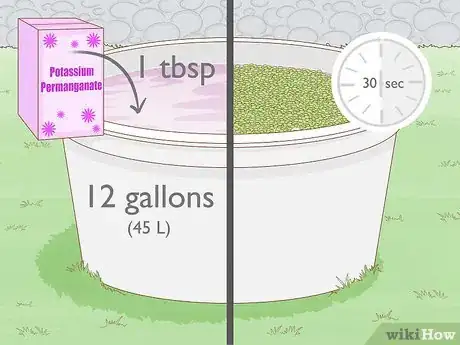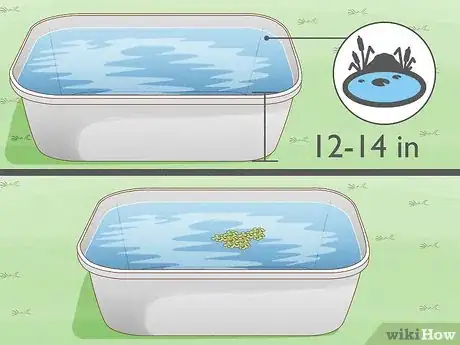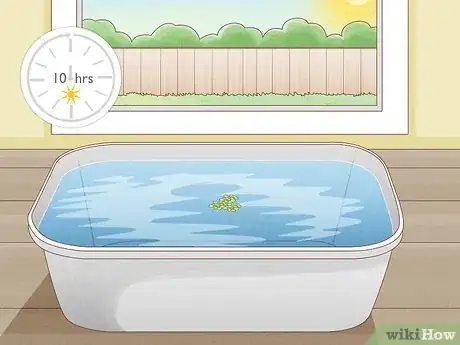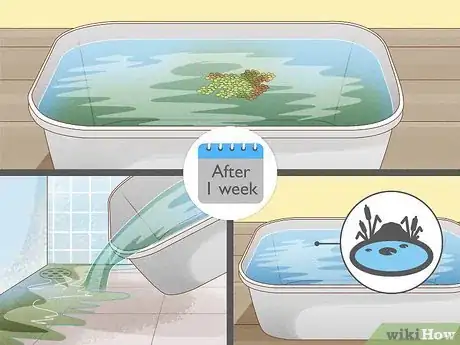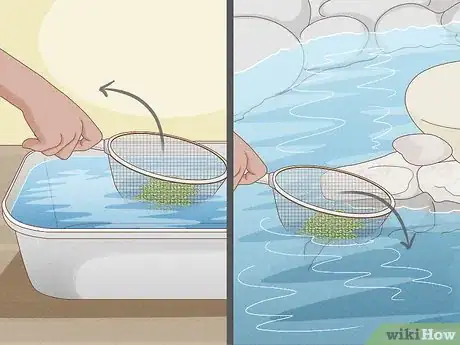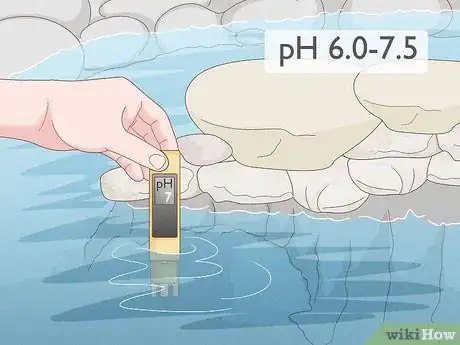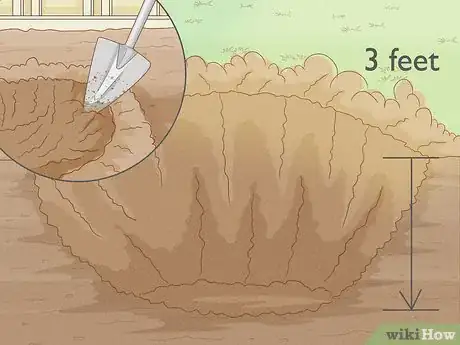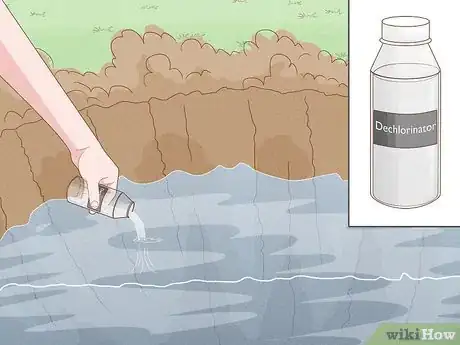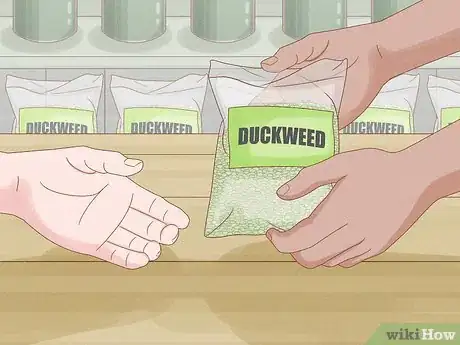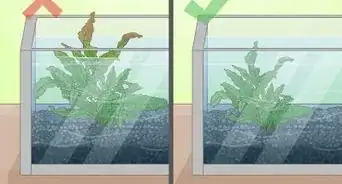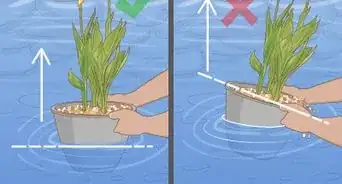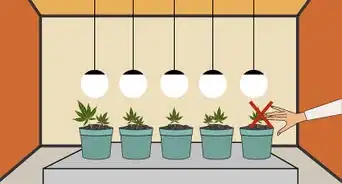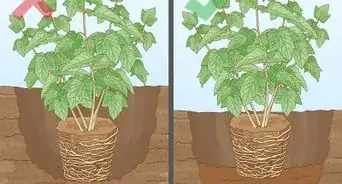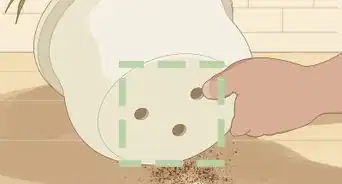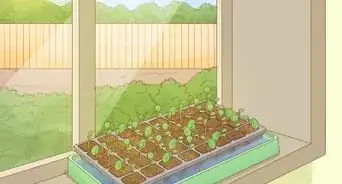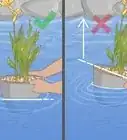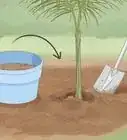This article was co-authored by wikiHow Staff. Our trained team of editors and researchers validate articles for accuracy and comprehensiveness. wikiHow's Content Management Team carefully monitors the work from our editorial staff to ensure that each article is backed by trusted research and meets our high quality standards.
There are 7 references cited in this article, which can be found at the bottom of the page.
wikiHow marks an article as reader-approved once it receives enough positive feedback. In this case, 87% of readers who voted found the article helpful, earning it our reader-approved status.
This article has been viewed 122,257 times.
Learn more...
Duckweed is an aquatic plant that is commonly found in lakes, forming what seems to be a green blanket over the water. Easily grown, it is a natural food for many animals and keeps mosquitoes from breeding on the water. If you would like to grow some for a science project, animal feed, or for fun, you can grow it indoors or outside in a pond.
Steps
Growing Duckweed Indoors
-
1Buy some duckweed at a pet store or harvest it from a pond. You might be able to buy some duckweed from pet stores in your area. Otherwise, you can take it from a pond it's growing in. Fill your container with some water from the pond. Then scoop some duckweed from the pond with your hand and place the duckweed into your container.[1]
- Place the lid on the container to prevent splashing while you bring the duckweed home.
- Between 50-100 duckweed pods will be enough as they will grow and multiply quickly.
-
2Disinfect the duckweed with potassium permanganate. You'll need potassium permanganate to disinfect the duckweed. Mix one teaspoon of this chemical in 12 gallons (45 L) of water. Place the duckweed into the permanganate solution for 30 seconds or so.[2]
- Potassium permanganate can be bought at your local pharmacy.
- Disinfecting the duckweed will make sure that it is free of pests and bacteria.
Advertisement -
3Place the duckweed in a plastic tray with 12–14 inches (30–36 cm) of depth. This will help you create a suitable environment for the duckweed to thrive in. Fill the tray with freshwater and add the duckweed to it. Use freshwater from a pond for best results but you can also use tap water.[3]
- You need to use freshwater as duckweeds are freshwater plants. This is why they only grow in ponds and not at sea. Salt water will kill the duckweed.
-
4Position the tray so it receives 10 hours of sunlight daily. The best place to put the tray is right next to a window that receives at least 10 hours of sunlight each day. Like many plants, duckweed will thrive in direct sunlight. If you see duckweed in a pond, notice how the pond is almost completely without any shade and receiving plenty of sunlight.
- If you can't put duckweed near a window that receives 10 hours of sunlight, you can also use fluorescent light bulbs to help them grow. For best results, place the light bulbs 15 inches (38 cm) above the tray. The duckweed won't grow under these light bulbs as well as it would with direct sunlight.
-
5Change the water in the tray after 1 week. Check the tray a couple of times a day and remove damaged duckweed from the tray. Replace the water in the tray with more freshwater.[4]
- It will take 10 days or so for the duckweed to multiply.
-
6Use a net to transfer the multiplied duckweed to your desired location. If transferring the duckweed to a pond in your garden, make sure that the pond is receiving plenty of sunlight. If you're moving the duckweed to an aquarium, make sure that the aquarium lid has a light source attached to it.[5]
- Duckweed requires no further care or maintenance once it's in your pond or aquarium.
- You can get a suitable net in your local garden store.
Growing Duckweed Outside
-
1Test to see if your pond's pH level is between 6.0 and 7.5. Duckweed grows best at between these 2 numbers. To find out the pH of the water in your pond, dip some litmus paper into the pond. Depending on how acidic or basic the water is, the paper will turn a color between red (highly acidic) and blue (very basic). If the paper is between a dark yellow and lime green in color, the pond water is suitable to use for your duckweed.[6]
- Buy some litmus paper at your local pharmacy.
- If the pH of your pond is too acidic, use baking soda at a rate of 1 teaspoon for every 5–10 gallons (19–38 L) of water. Do this until the pH reaches the 6.0 to 7.5 range.[7]
-
2Create a pond if you don't have one. The best place to dig your pond is an area that isn't low in elevation, has no muddy soil, and doesn't flood from excessive rain. Create steep slopes around the pond. The pond should be at least 3 feet (0.91 m) deep.[8]
- Don't place the pond too close to trees or to other things that might cast a shadow over it. Duckweed needs plenty of sunlight to be able to grow.
- Using a waterproof plastic tarp or a pond liner, cover the pond's bottom surface area. Make sure there is at least a few feet extra of tarp extending around the ditch.
- Cover the tarp with soil. Raise an edge/water-run-off barrier around it. Try adding some stones around the edges.
-
3Fill your pond with freshwater if you built a pond. Duckweed will also grow in tap water once the pH is suitable. Fill your pond until the water reaches 1 foot (0.30 m) from the top of the pond. This will prevent flooding.[9]
- You might be able to buy large tanks of freshwater from your local garden store. If not, you can use tap water.
-
4Add a dechlorinator to your pond. You can buy a dechlorinating agent at your local pet store. Read the packaging to find out how much water the agent is designed to treat. Unscrew the lid of the agent and pour the desired amount into your pond. This will remove chlorine from your pond.[10]
- Duckweed grows best in dechlorinated ponds.
-
5Buy duckweed from a pet shop or harvest it from a pond. It's unlikely but you should check to see if your local pet store sells duckweed before you head to the local pond. If the pet stores don't have duckweed, find a pond with duckweed in it. Fill a container with fresh water from the pond and scoop the duckweed into the container.[11]
- 50-100 duckweed pods will be enough.
- You can also use plastic drinking bottles to collect the duckweed. Just make sure you've properly washed the bottle out beforehand.
-
6Disinfect the duckweed with potassium permanganate. You can buy this chemical from your local pharmacy. Mix one teaspoon of potassium permanganate in 12 gallons (45 L) of water. Add the duckweed to this mixture and let it sit for 30 seconds. When the 30 seconds are up, remove the duckweed from the mixture and add it back to your container of freshwater.[12]
-
7Add the duckweed to your pond. Take the containers to the pond and place the duckweed into your pond. After 10 days or so, you should be able to notice the duckweed multiplying.[13]
- If you're putting other plants in your pond, pick plants that don't require plenty of sunlight. The duckweed will block most of the light from entering the pool.
- Duckweed requires no further care or maintenance once it's in your pond or aquarium.
Community Q&A
-
QuestionCan feed duckweed to my pets?
 Masen YoungCommunity AnswerNo. The main purpose of duckweed is to shelter creatures. Having your pets eat duckweed is like having your pets eat tree bark. It has very little nutritional value, and is bad for animals.
Masen YoungCommunity AnswerNo. The main purpose of duckweed is to shelter creatures. Having your pets eat duckweed is like having your pets eat tree bark. It has very little nutritional value, and is bad for animals. -
QuestionWhat does duckweed need to eat?
 Community AnswerStill water and sunshine. Place it in an aquarium or bucket of water outside.
Community AnswerStill water and sunshine. Place it in an aquarium or bucket of water outside.
Warnings
- In most places, duckweed is viewed as a weed, good for a private pond. Do not release it into any sewer, lake, or river.⧼thumbs_response⧽
- Some cities do not allow people to have natural ponds over a certain size in a certain location. Check with your local regulations.⧼thumbs_response⧽
- In aquariums, especially if it's warm (over 70 °F (21 °C)), it will grow very quickly![15]⧼thumbs_response⧽
Things You'll Need
Growing Duckweed Indoors
- Duckweed
- Containers for transporting the duckweed
- Potassium permanganate
- A plastic tray with 12–14 inches (30–36 cm) of depth
- Direct sunlight or fluorescent bulbs
- Freshwater
- A net
Growing Duckweed Outside
- Litmus paper
- Freshwater or tap water
- A dechlorinating agent
- A Shovel
- Plastic tarp
- Potassium permanganate
- Duckweed
- Dechlorinated water
- Containers
References
- ↑ https://gardenerdy.com/how-to-grow-duckweed
- ↑ https://gardenerdy.com/how-to-grow-duckweed
- ↑ https://gardenerdy.com/how-to-grow-duckweed
- ↑ https://gardenerdy.com/how-to-grow-duckweed
- ↑ https://gardenerdy.com/how-to-grow-duckweed
- ↑ https://duckweedgardening.com/2012/03/07/duckweed-growing-tips-and-tricks/
- ↑ http://www.koihealth.info/understanding-ph.html
- ↑ http://watergarden.com/pages/build_wg.html
- ↑ http://watergarden.com/pages/build_wg.html
- ↑ http://animals.mom.me/dechlorinate-water-hermit-crabs-1504.html
- ↑ https://gardenerdy.com/how-to-grow-duckweed
- ↑ https://gardenerdy.com/how-to-grow-duckweed
- ↑ https://gardenerdy.com/how-to-grow-duckweed
- ↑ http://aquaplant.tamu.edu/plant-identification/alphabetical-index/common-duckweed/
- ↑ https://gardenpool.org/online-classes/growing-duckweed

